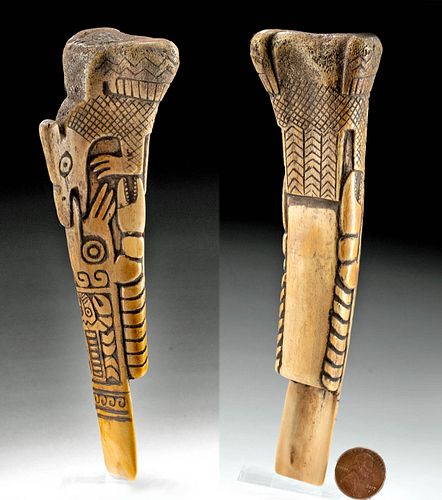Huari Llama Bone Drug Spoon w/ Bird & Crustaceans
Lot 180a
About Seller
Artemis Gallery
686 S Taylor Ave, Ste 106
Louisville, CO 80027
United States
Selling antiquities, ancient and ethnographic art online since 1993, Artemis Gallery specializes in Classical Antiquities (Egyptian, Greek, Roman, Near Eastern), Asian, Pre-Columbian, African / Tribal / Oceanographic art. Our extensive inventory includes pottery, stone, metal, wood, glass and textil...Read more
Estimate:
$1,600 - $2,400
Absentee vs Live bid
Two ways to bid:
- Leave a max absentee bid and the platform will bid on your behalf up to your maximum bid during the live auction.
- Bid live during the auction and your bids will be submitted real-time to the auctioneer.
Bid Increments
| Price | Bid Increment |
|---|---|
| $0 | $25 |
| $300 | $50 |
| $1,000 | $100 |
| $2,000 | $250 |
| $5,000 | $500 |
| $10,000 | $1,000 |
| $20,000 | $2,500 |
| $50,000 | $5,000 |
| $100,000 | $10,000 |
| $200,000 | $20,000 |
About Auction
By Artemis Gallery
Mar 24, 2022
Set Reminder
2022-03-24 10:00:00
2022-03-24 10:00:00
America/New_York
Bidsquare
Bidsquare : Exceptional Antiquities Ethnographic Fine Art
https://www.bidsquare.com/auctions/artemis-gallery/exceptional-antiquities-ethnographic-fine-art-9057
Museum-worthy examples of classical antiquities (Egyptian, Greek, Roman, Near Eastern), Viking, Far East / Asian, Pre-Columbian, African / Tribal, Oceanic, Native American, Spanish Colonial, Fossils, Ancient Jewelry, Fine / Visual Arts, so much more! Artemis Gallery info@artemisgallery.com
Museum-worthy examples of classical antiquities (Egyptian, Greek, Roman, Near Eastern), Viking, Far East / Asian, Pre-Columbian, African / Tribal, Oceanic, Native American, Spanish Colonial, Fossils, Ancient Jewelry, Fine / Visual Arts, so much more! Artemis Gallery info@artemisgallery.com
- Lot Description
Pre-Columbian, Central Peru, Huari (Wari) culture, ca. 700 to 1000 CE. A stunning hand-carved spoon made from the leg bone of a camelid, likely a llama with zoomorphic forms incised into the surface. The knobbed joint areas contain an avian or reptilian hybrid creature, the head rising in relief, the beak open as if biting or swallowing the rest of the bone carvings which consist of a lobster the claws and pincers delightfully visible on both sides. A second lobster incised into the venter of the main body with stippled geometric and decorative elements throughout. The bone shaft is shaped so that a panel to one side projects further out from the bone acting like a scoop, and the rest of the handle is hollowed out. Such an ornate tool may have been used for ceremonial preparation and ingestion of hallucinogenic drugs and may depict a mythical scene. Size: 6.25" L x 1.75" W (15.9 cm x 4.4 cm)
Spoons like this one were part of the elaborate battery of objects carefully manufactured by ancient Andeans in order to ingest a ground drug known as vilca or huilca, found in southern Peru and Bolivia, and obtained from the beans of the tree Anadenanthera colubrina. We know of them from burials, where they were placed as offerings and perhaps to provision the dead alongside inhalation tubes and other paraphernalia. Feline heads are some of the most important, and therefore common, artistic themes on drug paraphernalia from this region. They are associated with the use of psychoactive substances that could "transform" a shaman or priest into a feline.
Ancient Peruvians were keen observers of nature and as fishmen, would have been familiar with the bodies and movement of sea creatures like these. Crustaceans may have had special spiritual significance, as we know that the Moche people had a major marine deity in the form of a crab who fought against a fish monster in a periodic cycle of death and rebirth.
Provenance: private Hidden Valley Lake, California, USA collection
All items legal to buy/sell under U.S. Statute covering cultural patrimony Code 2600, CHAPTER 14, and are guaranteed to be as described or your money back.
A Certificate of Authenticity will accompany all winning bids.
PLEASE NOTE: Due to recent increases of shipments being seized by Australian & German customs (even for items with pre-UNESCO provenance), we will no longer ship most antiquities and ancient Chinese art to Australia & Germany. For categories of items that are acceptable to ship to Australia or Germany, please contact us directly or work with your local customs brokerage firm.
Display stands not described as included/custom in the item description are for photography purposes only and will not be included with the item upon shipping.
#170507Minor surface nicks with natural ossification, otherwise intact and choice. Beautiful dark patina throughout.Condition
- Shipping Info
-
All shipping is handled in-house for your convenience. Your invoice from Artemis Gallery will include shipping calculation instructions. If in doubt, please inquire BEFORE bidding for estimated shipping costs for individual items.
-
- Buyer's Premium



 EUR
EUR CAD
CAD AUD
AUD GBP
GBP MXN
MXN HKD
HKD CNY
CNY MYR
MYR SEK
SEK SGD
SGD CHF
CHF THB
THB















